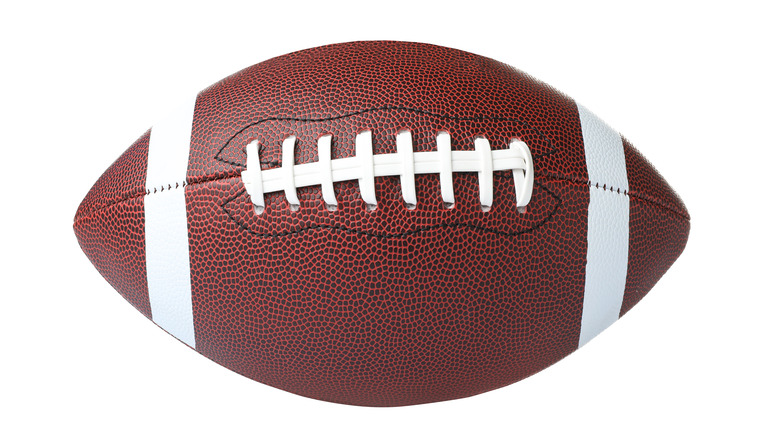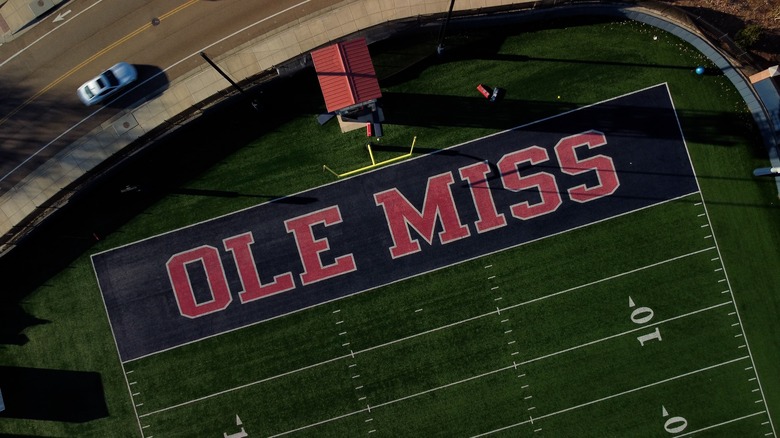The History Of Mike Leach's Famous 'Air Raid' Offense
The modern football game, whether played in NFL stadiums or on the college or even high school or pee wee league field, is as much a passing game as it is a running game. However, originally gridiron football (as it's called in order to distinguish it from association football, or soccer) was played entirely on the ground, and the concept of throwing the ball to another player — the forward pass — didn't even take hold until 1906, nearly half a century after the first college football game (via History).
Crowds love it, of course; there's nothing like a 40-yard bomb to energize the 12th man and make the highlight reel on ESPN that day. However, winning on the field requires a combination of running plays and passing plays, although some coaches and offensive coordinators may have a fondness for tilting the balance in favor of one system or the other. University of Mississippi coach Mike Leach (above) certainly favors the aerial game; his system has been called the "air raid" offense. And though he wasn't the man who came up with it, he definitely leaned into it, popularized it, and made it big.
The History Of The Forward Pass
Gridiron football as we know it emerged, like soccer and rugby, from an English "game" that was less of a game and more of an excuse for mob violence. As The Collector reports, towns would turn up to move a ball from one end of town to the other, and rules were nonexistent. Needless to say, injuries and deaths were not uncommon. When American college students started playing a version of the game in the late 1800s, it was largely an equally-dangerous free-for-all. However, by 1906 none other than the president of the United States, Teddy Roosevelt, was concerned about the injuries the athletes were exposed to, and the rules were tightened up to get ahead of things before the game was banned entirely, as History reports.
One of the rule changes allowed for throwing the ball — the forward pass, as it came to be known. But teams were reluctant to utilize it; "Many predict the ruination of the game through the drastic reformation," reported The New York Times at the time (via History). However, on September 5, 1906, history was made — Saint Louis University's Bradbury Robinson threw a pass that failed to connect. However, a few plays later he threw a 20-yard touchdown pass, and a new form of offense was born.
The Air Raid Offense
According to Ralph D. Russo of the Associated Press, "The air raid is more a process than a playbook these days. Keeping things simple, stressing execution over matchups and seemingly endless repetition of a relatively small number of plays in practice are what links the air raid's past and present."
JR Radcliffe of the Milwaukee Journal-Sentinel explains in a bit more detail: "With offensive linemen spread out at the line of scrimmage, it's incumbent that the quarterback get the ball out quickly (or decide to run) to offset blitzers that might try to take advantage of the wider openings up front. So, despite the name, it doesn't mean quarterbacks will be throwing deep passes regularly, but they'll need to throw the ball to all parts of the field."
Although Mike Leach is associated with the "air raid" offense, he didn't come up with it. According to the Milwaukee Journal-Sentinel, that would be Hal Mumme, who came up with it in the 1980s when he was coaching a high school team in Texas. When Mumme came up with the system, it was less about being a sea change in the way football is played and more about making lofty football concepts available to teenagers. "He was basically trying to dumb this thing down for guys that were just learning to play football," said his son, Matt, via the Associated Press.
Mumme eventually got a head coaching job at a major college football program — Kentucky — and passed the concept on to his assistant coach at the time, Leach. Leach eventually made his way to Mississippi, where the offensive system became a cornerstone of the team's playbook.


